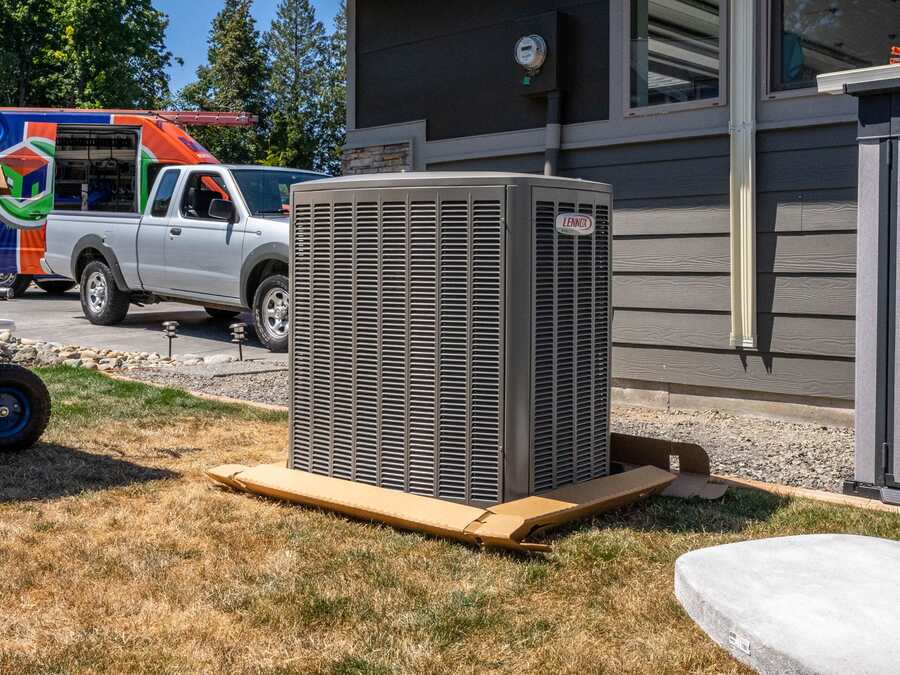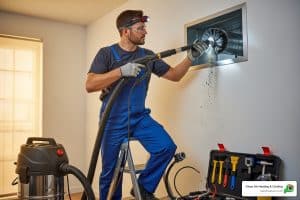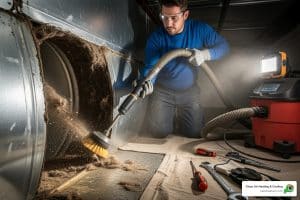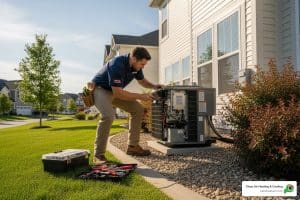Why Installing a Heat Pump Is a Smart Choice
Learning how to install heat pump systems can offer significant benefits for homeowners. Here’s a quick overview if you’re short on time:
- Overview: A heat pump can both heat and cool your home efficiently.
- Benefits: Reduced utility bills, lower carbon footprint, and increased comfort.
- Energy Efficiency: Heat pumps are 3 to 5 times more efficient than traditional HVAC systems.
Imagine your furnace failing during a cold snap, leaving you shivering. This scenario happened to me, and it spurred my interest in switching to a heat pump. Not only are heat pumps efficient, but they are also environmentally friendly, using electricity to move heat rather than burning fossil fuels. This means lower energy costs and a smaller carbon footprint.
Colin Matei here, owner of Clean Air Heating & Cooling. With years of experience in how to install heat pump systems, my team ensures seamless installations that maximize efficiency and comfort. Read on to find more about these versatile, cost-effective systems.

What Is a Heat Pump?
A heat pump is an energy-efficient machine that can both heat and cool your home. Think of it as an all-in-one HVAC system that transfers heat from one place to another. Unlike traditional systems that burn fuel to create heat, heat pumps move existing heat, making them highly efficient.
How Does a Heat Pump Work?
A heat pump operates through a cycle of evaporation, compression, condensation, and expansion:
- Evaporation: The refrigerant absorbs heat from the surroundings and evaporates into a gas.
- Compression: The compressor increases the pressure and temperature of the gas.
- Condensation: The gas releases heat as it condenses back into a liquid.
- Expansion: The liquid refrigerant’s pressure drops, cooling it down to restart the cycle.
This cycle allows the heat pump to move heat into your home during winter and expel heat outside during summer.
Types of Heat Pumps
There are three main types of heat pumps:
- Air-Source Heat Pumps (ASHP)
- Most Common: ASHPs are the most widely used and are suitable for both heating and cooling.
- How They Work: They extract heat from the outdoor air and transfer it inside during winter. In summer, they reverse the process to cool your home.
- Efficiency: Effective in moderate climates but may need supplemental heating in extremely cold weather.
- Water-Source Heat Pumps
- How They Work: These systems use water bodies like lakes, rivers, or wells as the heat exchange medium.
- Efficiency: They are usually more efficient than air-source pumps but require access to a water source.
- Geothermal (Ground-Source) Heat Pumps
- How They Work: Geothermal heat pumps use the stable temperatures of the ground to provide heating and cooling. They require ground loops to be installed either vertically or horizontally.
- Efficiency: Extremely efficient year-round due to the constant ground temperature. Ideal for those seeking the most efficient system possible.
Why Choose a Heat Pump?
- Energy Efficiency: Heat pumps are 3 to 5 times more efficient than traditional HVAC systems because they move heat rather than generate it.
- Cost Savings: Lower your utility bills by reducing energy consumption.
- Environmental Impact: Reduce your carbon footprint by using a system that relies on electricity rather than burning fossil fuels.
By understanding the basics of how to install heat pump systems and their types, you can make an informed decision on the best system for your home. Next, we’ll dive into the steps to prepare for your installation.
Things To Consider Before Installing a Heat Pump
Before diving into the installation of a heat pump, there are several key factors you need to consider to ensure the system will work efficiently for your home. These considerations will help you choose the right heat pump and prepare your home for its installation.
Home Efficiency
Home efficiency is crucial when installing a heat pump. If your home is inefficient, the heat pump will have to work harder, reducing its effectiveness and increasing your energy bills.
Insulation: Make sure your home is well-insulated. Poor insulation means heat can easily escape during winter and enter during summer, making your heat pump work overtime. Improving your insulation can significantly boost the efficiency of your new system.
Air Leaks: Check for air leaks around windows, doors, and any other openings. Sealing these leaks will help maintain a consistent indoor temperature and reduce the load on your heat pump.
Heat Pump Size
Choosing the right heat pump size is essential for maximum efficiency. A heat pump that is too small will struggle to heat or cool your home, while one that is too large will cycle on and off frequently, wasting energy.
- Consult a Professional: It’s best to work with an HVAC professional to determine the correct size of the heat pump for your home. They will consider factors such as the size of your home, insulation levels, and local climate conditions.
HVAC Professional Consultation
Given the complexity and importance of a heat pump installation, consulting with an HVAC professional is highly recommended.
- Expert Advice: Professionals can provide expert advice on the best heat pump for your specific needs, taking into account your home’s layout, climate, and efficiency requirements.
- Installation Precision: A professional ensures that the installation is done correctly, safely, and in compliance with local regulations. This is crucial for the longevity and performance of your heat pump.
Additional Considerations
- Homeowners Association (HOA) Approval: If you live in a community with an HOA, you may need to get approval before installing a heat pump. Check with your HOA to avoid any potential issues.
- Space Requirements: Ensure you have enough space for both the indoor and outdoor units of the heat pump. The outdoor unit should be placed on a level surface, preferably on a composite pad, and should have adequate clearance for proper airflow.
- Timeline: Plan the installation process to minimize disruption to your daily life. Be prepared to be without heating or cooling for a short period during the installation.
By addressing these considerations, you can ensure that your heat pump operates efficiently and effectively, providing you with comfortable indoor temperatures year-round.
Next, we’ll guide you through the preparation steps for installing a heat pump.
Preparing To Install a Heat Pump
Before diving into the actual installation, it’s crucial to prepare properly. Here are the key steps you need to follow to ensure a smooth and efficient installation process.
Space Requirements
First, make sure you have the necessary space for both the indoor and outdoor units of the heat pump.
- Indoor Unit: Typically, the indoor unit is an air handler. Ensure there’s enough space inside your home for this unit, considering ventilation and accessibility for maintenance.
- Outdoor Unit: The outdoor unit needs a level surface and adequate clearance for proper airflow. Ideally, it should be placed on a composite pad to keep it stable and liftd from the ground.
HOA Approval
If you live in a neighborhood with a Homeowners Association (HOA), you’ll need to get their approval before installing a heat pump.
- Check HOA Guidelines: Review your HOA’s rules and regulations regarding home improvements. Some HOAs have specific guidelines on where you can place outdoor units or what types of equipment are allowed.
- Submit Plans for Approval: Prepare a detailed plan of where you intend to install the heat pump and submit it to your HOA for approval. This step can save you from potential fines or having to move the unit later.
Timeline
Plan your installation timeline carefully to minimize disruption to your daily life.
- Schedule Installation: Coordinate with the installer to set a clear timeline for the project. Ensure you know how long you’ll be without heating or cooling.
- Weather Considerations: If possible, plan the installation during a season when you can comfortably live without heating or cooling for a few days.
Composite Pad Installation
The outdoor unit of your heat pump needs a stable, level surface to sit on. Installing a composite pad is a critical step.
- Choose the Location: Select a location that is level and has adequate clearance from walls, plants, and other obstructions. This ensures proper airflow and easy access for maintenance.
- Prepare the Ground: Clear the area of debris and level the ground. You may need to dig a shallow area to place the pad securely.
- Install the Pad: Place the composite pad on the prepared ground. Ensure it’s level and stable. This pad will support the outdoor unit, keeping it liftd and protected from ground moisture.

By carefully preparing your home for the heat pump installation, you can ensure a smoother process and better performance from your new system. Next, we’ll walk you through how to disconnect the old heat pump and install the new system.
How to Install a Heat Pump
Disconnecting the Old Heat Pump
Before installing a new heat pump, you need to safely remove the old one. This step involves handling hazardous refrigerants, so it’s usually best left to professionals.
- Hazardous Refrigerants: Heat pumps contain refrigerants that are harmful to the environment. According to EPA standards, it’s illegal to vent these chemicals into the atmosphere.
- Recovery Machine: A professional installer will use a recovery machine to capture the refrigerant safely. This step ensures compliance with environmental regulations and prepares the system for removal.
Once the refrigerant is safely removed, the old heat pump can be disconnected from the electrical and duct systems.
Installing the New Heat Pump System
With the old system out of the way, it’s time to install the new heat pump. This process involves several critical components:
Indoor Evaporator Coil
The indoor evaporator coil is essential for the heat pump’s operation.
- Remove the Old Coil: Professionals will remove the existing evaporator coil, which connects to the refrigerant lines.
- Install the New Coil: There are two types of coils: cased and uncased. A cased coil is easier to handle since it’s already protected. The new coil is installed and connected to the refrigerant lines.
Line Sets, Wiring, and Valves
Next, the installers will focus on the line sets and wiring.
- Line Sets: These copper lines transport refrigerant between the indoor and outdoor units. The installer will weld the new lines to ensure a leak-free connection.
- Wiring: Electrical wires are essential for the heat pump’s operation. The installer will replace old wires and ensure the new ones are correctly connected.
- Valves: A valve allows the system to switch between heating and cooling modes. The installer will check and replace this valve if necessary.
Thermostat Setup
The thermostat controls the heat pump’s operation.
- Inspect and Upgrade: The installer will inspect the existing thermostat wiring and upgrade it if needed.
- Connect and Test: The new thermostat is connected to the system and tested to ensure it can effectively control both heating and cooling functions.
Installing the Outdoor Unit
The outdoor unit is the powerhouse of your heat pump system.
- Composite Pad: Place the outdoor unit on a stable, level composite pad. This pad helps keep the unit liftd, reducing the risk of snow and ice damage.
- Elevation: Elevating the unit also improves airflow and prevents debris from blocking the system.
Connecting to Electrical and Duct Systems
Finally, connect the new heat pump to your home’s electrical and duct systems.
- Electrical System: The installer will connect the heat pump to your home’s electrical system, ensuring all connections are secure and compliant with local codes.
- Air Duct System: If your home has existing ductwork, the installer will connect the new heat pump to this system. Any necessary alterations will be made to ensure optimal airflow.
Commissioning Phase
Once everything is connected, the heat pump goes through a commissioning phase.
- Testing: The installer will run the heat pump through its paces, testing the heating, cooling, and defrost functions. This phase lasts up to 45 minutes.
- Final Checks: The thermostat and other systems are checked to ensure everything is working correctly.
By following these steps, you can ensure a smooth and efficient installation of your new heat pump. For professional help, consider contacting Clean Air Heating & Cooling. Our experienced technicians can handle every aspect of the installation, ensuring your new system operates at peak efficiency.
DIY Heat Pump Installation Tips
Thinking about installing a heat pump yourself? It can save you money, but know what you’re getting into. Here are some tips to help you with your DIY heat pump installation.
Cost-Saving Tips
Installing a heat pump yourself can save you thousands of dollars. For example, Dave Killen from Portland managed to install his heat pump for around $4,300, plus an additional $1,600 for necessary items like a new electrical panel and concrete pad.
- Gather Multiple Estimates: Before starting, get multiple estimates for both the heat pump unit and any professional services you might need. This can help you find the best deal.
- Shop Around for Heat Pumps: Look for deals online. Sometimes, buying a heat pump online can be cheaper than purchasing from a local retailer.
Professional Help
Even if you’re going the DIY route, some tasks are best left to the pros.
- Electrical Work: Upgrading or installing a new electrical panel should be done by a licensed electrician. Dave got help from an electrician for this part.
- Refrigerant Handling: Handling refrigerants requires specialized equipment and knowledge. A professional can ensure that this is done safely and legally.
Timing
Timing your project can make a big difference.
- Seasonal Considerations: Plan your installation during milder weather. Dave aimed to finish his project by May, after the heating season ended but before the cooling season began.
- Delivery and Installation Timeline: Order your equipment ahead of time and work on the project in stages. This way, you’re not left without heating or cooling when you need it most.
Refrigerant Lines
Refrigerant lines are crucial for your heat pump’s operation.
- Order Extra Length: It’s wise to order longer refrigerant lines than you think you’ll need. This can prevent running short and having to reorder.
- Check for Leaks: After installation, check for leaks in the refrigerant lines. Dave had a small leak from a bad solder joint but was able to fix it quickly.
Electric Heat Strips
Electric heat strips can act as a backup heating source.
- Install Immediately or Later: You can choose to install electric heat strips right away or wait to see if you need them. These strips can be a lifesaver during extremely cold weather when your heat pump might struggle.
- Energy Efficiency: While heat strips can provide necessary backup heat, they are less efficient than the heat pump itself. Use them sparingly to save on energy costs.
By following these tips, you can tackle your heat pump installation project more confidently. It’s always a good idea to consult with professionals for the more complex parts of the job. For more detailed guidance or professional assistance, consider reaching out to Clean Air Heating & Cooling.
Frequently Asked Questions about How to Install a Heat Pump
Can I install a heat pump myself?
Yes, you can install a heat pump yourself, but it’s not for everyone. DIY installation can save you a lot of money, but it requires a good understanding of HVAC systems, electrical work, and refrigerant handling. For instance, Dave Killen managed to install his heat pump for around $4,300, plus an additional $1,600 for necessary items like a new electrical panel and concrete pad. However, he still needed some professional help, especially for electrical work and handling refrigerants.
Key Points:
– Cost Savings: DIY can save thousands.
– Professional Help: Some tasks, like electrical work, should be done by licensed professionals.
– Skills Required: Understanding of HVAC, electrical systems, and refrigerants is crucial.
Is a heat pump easy to install?
Installing a heat pump is not inherently easy, but it is manageable with the right skills and preparation. The process involves multiple steps, including disconnecting the old system, setting up the new indoor and outdoor units, and connecting electrical and duct systems.
Considerations:
– Complexity: The job requires knowledge of various home systems.
– Time: It can be time-consuming, especially for first-timers.
– Tools and Equipment: Specialized tools and equipment are often needed.
Can I add a heat pump to my existing HVAC system?
Yes, you can add a heat pump to your existing HVAC system. This is often a good way to improve energy efficiency and reduce heating and cooling costs. However, consult with an HVAC professional to ensure compatibility and proper integration.
Steps to Consider:
– Assessment: Have a professional assess your current HVAC system.
– Compatibility: Ensure the new heat pump is compatible with your existing setup.
– Installation: Professional installation is recommended for optimal performance.
For more detailed guidance or professional assistance, consider reaching out to Clean Air Heating & Cooling.
Conclusion
Installing a heat pump is a significant decision that offers numerous benefits, from energy efficiency to cost savings. While the process can be complex, understanding each step—from preparation to installation—ensures a smooth transition to a more sustainable home heating and cooling system.
Summary:
– Energy Efficiency: Heat pumps are highly efficient, often three to five times more efficient than traditional HVAC systems.
– Cost Savings: With the right installation and maintenance, heat pumps can significantly reduce your utility bills.
– Environmental Impact: Heat pumps reduce carbon footprint by utilizing existing energy, aligning with eco-friendly practices.
Clean Air Heating & Cooling is here to make your heat pump installation as seamless as possible. Our experienced professionals handle everything from initial consultation to final walkthrough, ensuring your system is set up correctly and efficiently.
Contact Us:
If you’re ready to explore the benefits of a heat pump or need professional assistance with installation, contact Clean Air Heating & Cooling. Our team is dedicated to providing top-notch service and ensuring your home remains comfortable year-round.
Feel free to reach out for a free estimate or any questions you might have. We’re here to help you make the best decision for your home’s heating and cooling needs.






